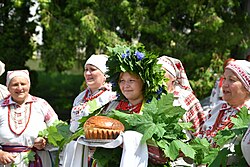
While genealogists often focus on direct-line ancestors from whom they descend (either biologically or as documented in historic records), in a more general sense, ancestors can be anyone who “went before” or who contributed to the family history of an individual. The word ancestor comes from the Latin roots ante (before) and cedere (to go) thus signifying “one who goes before.” This broader concept of ancestry can include siblings, aunts, uncles and other collateral relatives of direct ancestors, anyone who was “like a family” to direct ancestors, as well as friends, neighbors, and associates of direct ancestors. Often, it is the exploration of these broader families and communities that can transform genealogical details of names, dates, and places into a deeper understanding of family stories and an individual’s place within the history of their family, community, and nation.[1]
Research your ancestors on MyHeritage
Benefits of researching and learning ancestor’s storiesBenefits of researching and learning ancestor’s stories

Some of the many benefits of learning about ancestors and an individual’s family history include:
- Stronger confidence, self-esteem, and self-control[2]
- Increased self-awareness and sense of identity
- Higher levels of emotional well-being
- Improved intellectual performance[3]
- Connection across generations and connection to communities[4][5]
- Ability to plan for the future
- Resilience in facing challenges[6]
Many genealogists and family history researchers find that identification of ancestors and exploration of their stories (both positive and negative) help individuals understand their place and role in their own families, communities, and history. While uncovering uncomfortable truths about one’s family history can be shocking and upsetting, at the same time, exploration of the trauma and challenges that ancestors faced can also be therapeutic in highlighting narratives of resilience and in identifying examples and non-examples of narratives to emulate or avoid.
How to research ancestors' storiesHow to research ancestors' stories

Family historians rely on original and primary sources as well as compiled and secondary sources to assemble facts, information, and evidence relating to their ancestor’s lives. Sometimes sources of information originate from family oral history, interviews, photographs, documents, journals, family heirlooms heirlooms and other home sources. Other times, information regarding ancestors comes from records created by churches, governments, businesses, and other organizations with which an ancestor interacted. For all facts and information items that genealogists uncover, they cite the origin of that information and if possible link to the original images and data sources. In assembling evidence, family historians also evaluate the reliability of different sources, and correlate information and evidence from different sources. When conflicts between sources arise, researchers attempt to resolve conflicts through further research and evaluation of evidence until they can confidently assert their findings in written conclusions. In the process of crafting family narratives, and as a means of evaluating and analyzing evidence, researchers also consider geographic, legal, historical, and other context for the times and places in which their ancestors lived.
Sometimes the lack of original records due to record destruction, record loss, or no records being created in the first place can complicate efforts to trace the genealogical connections between ancestors or learn more about their history. In these instances, genetic testing can aid in revealing family relationships and connecting with collateral relatives who may have more information or for whom records do exist. On the other hand, genetic testing can also reveal conflicts between the relationships proposed through documentary sources and the biological relationships suggested through relationships to genetic cousins and DNA matches. While these discoveries, too, can be surprising and even traumatic, cases of misattributed parentage, unknown parentage or adoption (for an individual or their ancestors) can further expand the definitions of family, heritage, and ultimately the identities of who is considered an ancestor.
See alsoSee also
Explore more about ancestorsExplore more about ancestors
- Identifying Common Ancestors with DNA on the MyHeritage Knowledge Base
- Visualizing Ancestral Lines with DNA AutoClusters on the MyHeritage Knowledge Base
- How to Find Out If You Have Royal Ancestry on the MyHeritage Knowledge Base
- How to Find Out if Your Ancestors Were Conversos on the MyHeritage Knowledge Base
- These Toddlers Look Just Like Their Ancestors on the MyHeritage blog
- Future-proof Your Family History: How to Make Sure Your Genealogy Research Outlives You on the MyHeritage blog
- From Samhain to Day of the Dead: Celebrating Departed Ancestors Across the Globe on the MyHeritage blog
- We Celebrated Grandma’s 100th with a MyHeritage Sun Chart of Her 140+ Descendants on the MyHeritage blog
- The Secret to Finding Your Ancestors’ Stories at Legacy Family Tree Webinars
- Searching for My Ancestors’ Records at Legacy Family Tree Webinars
- Elusive Ancestors: Never Too Poor to Trace at Legacy Family Tree Webinars
- Encounters – Our Immigrant Ancestors at Legacy Family Tree Webinars
References
- ↑ Harding, Rosalind, M. (1998), "New phylogenies: an introductory look at the coalescent.", in Nee, S (ed.), New uses for new phylogenies, Oxford University Press, ISBN 0-19-854984-9
- ↑ Robyn Fivush, Marshall Duke, and Jennifer G. Bohanek, ’Do You Know…’ The power of family history in adolescent identity and well-being. National Council on Public History. 23 February 2010
- ↑ Peter Fischer, Anne Sauer, Claudia Vogrincic, and Silke Weisweiler, “The ancestor effect: Thinking about our genetic origin enhances intellectual performance,” European Journal of Social Psychology, vol. 41, no. 1 (February 2011), pp.11-16
- ↑ Rakesh Maurya, “Use of Family Narratives as a Tool of Effective Parenting,” International Journal of Indian Psychology, vol. 3, no. 25 (30 January 2016), pp. 2348-5396
- ↑ Anna Lima, Family History and Genealogy: The Benefits for the Listener, the Storyteller and the Community. Journal of Cape Verdean Studies, vol. 4, no. 1 (2019), pp. 63-74
- ↑ Martha Driessnack, ’Who Are You From?’: The Importance of Family Stories. Journal of Family Nursing, vol. 23, no. 4, (23 October 2017)

